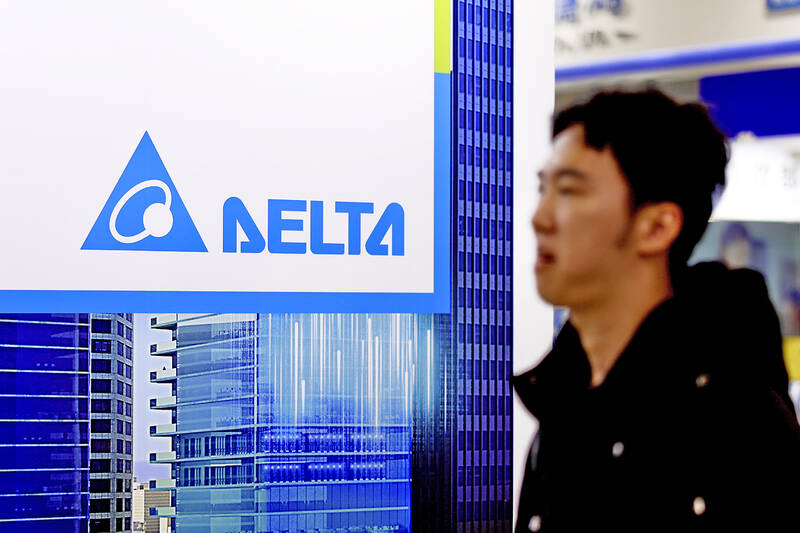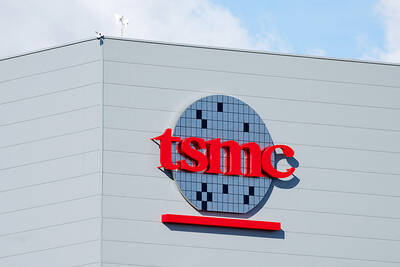Delta Electronics Inc (台達電) expects strong sales momentum this quarter to sustain next quarter, investor relations manager Rodney Liu (劉致遠) said on Friday, citing potential shipment growth in power electronics and a favorable product mix.
Power electronics products accounted for 52 percent of Delta’s total sales of NT$124 billion (US$4.06 billion) last quarter, followed by infrastructure products at 28 percent, automation devices at 11 percent and mobility applications at 9 percent.
Power electronics products include high-powered power supply modules, power supply units, high-efficiency adapters and backup battery units, while infrastructure products include uninterruptible power supplies, power distribution units, high-voltage direct-current (HVDC) systems and liquid cooling systems, the company said.

Photo: Ritchie B. Tongo, EPA-EFE
Demand for power electronics and liquid-to-air heat dissipation racks this quarter has exceeded expectations, after issues such as overheating during the assembly of Nvidia Corp’s GB200 server were resolved, Liu said.
While shipments of liquid-to-air heat dissipation racks next quarter remain uncertain, the company’s overall performance in the second half of this year is expected to exceed the first half’s NT$242.9 billion due to seasonality, in line with earlier guidance, he said.
Some of Nvidia’s server contract manufacturers have reported order changes due to product transition from the GB200 to GB300 series since July, but the impact on Delta has been limited thanks to its diverse customer portfolio, Liu said.
The company mainly supplies in-rack coolant distribution units, liquid-to-air busbars, HVDC systems and grid-to-chip infrastructure solutions for the GB200 model, while providing high-power capacitor modules with lithium-ion capacitors and efficient power shelves for the GB300 model, Delta said.
Orders for power supply and liquid cooling products for the two server models have remained strong, Liu said.
Delta is also developing power supply products for an 800-volt high-voltage direct-current (DC) structure and a +/-400-volt DC system, both of which are undergoing safety certification, with mass production slated for the second half of next year if all goes smoothly, he said.
Among the company’s clients, three of the world’s four leading cloud service providers — Amazon.com Inc, Alphabet Inc, Microsoft Corp and Meta Platforms Inc — have adopted the +/-400-volt system, with one opting for the 800-volt system, Liu said.
Nvidia is promoting the 800-volt system, he said.

Taiwan Semiconductor Manufacturing Co (TSMC, 台積電) secured a record 70.2 percent share of the global foundry business in the second quarter, up from 67.6 percent the previous quarter, and continued widening its lead over second-placed Samsung Electronics Co, TrendForce Corp (集邦科技) said on Monday. TSMC posted US$30.24 billion in sales in the April-to-June period, up 18.5 percent from the previous quarter, driven by major smartphone customers entering their ramp-up cycle and robust demand for artificial intelligence chips, laptops and PCs, which boosted wafer shipments and average selling prices, TrendForce said in a report. Samsung’s sales also grew in the second quarter, up

LIMITED IMPACT: Investor confidence was likely sustained by its relatively small exposure to the Chinese market, as only less advanced chips are made in Nanjing Taiwan Semiconductor Manufacturing Co (TSMC, 台積電) saw its stock price close steady yesterday in a sign that the loss of the validated end user (VEU) status for its Nanjing, China, fab should have a mild impact on the world’s biggest contract chipmaker financially and technologically. Media reports about the waiver loss sent TSMC down 1.29 percent during the early trading session yesterday, but the stock soon regained strength and ended at NT$1,160, unchanged from Tuesday. Investors’ confidence in TSMC was likely built on its relatively small exposure to the Chinese market, as Chinese customers contributed about 9 percent to TSMC’s revenue last

With this year’s Semicon Taiwan trade show set to kick off on Wednesday, market attention has turned to the mass production of advanced packaging technologies and capacity expansion in Taiwan and the US. With traditional scaling reaching physical limits, heterogeneous integration and packaging technologies have emerged as key solutions. Surging demand for artificial intelligence (AI), high-performance computing (HPC) and high-bandwidth memory (HBM) chips has put technologies such as chip-on-wafer-on-substrate (CoWoS), integrated fan-out (InFO), system on integrated chips (SoIC), 3D IC and fan-out panel-level packaging (FOPLP) at the center of semiconductor innovation, making them a major focus at this year’s trade show, according

DEBUT: The trade show is to feature 17 national pavilions, a new high for the event, including from Canada, Costa Rica, Lithuania, Sweden and Vietnam for the first time The Semicon Taiwan trade show, which opens on Wednesday, is expected to see a new high in the number of exhibitors and visitors from around the world, said its organizer, SEMI, which has described the annual event as the “Olympics of the semiconductor industry.” SEMI, which represents companies in the electronics manufacturing and design supply chain, and touts the annual exhibition as the most influential semiconductor trade show in the world, said more than 1,200 enterprises from 56 countries are to showcase their innovations across more than 4,100 booths, and that the event could attract 100,000 visitors. This year’s event features 17